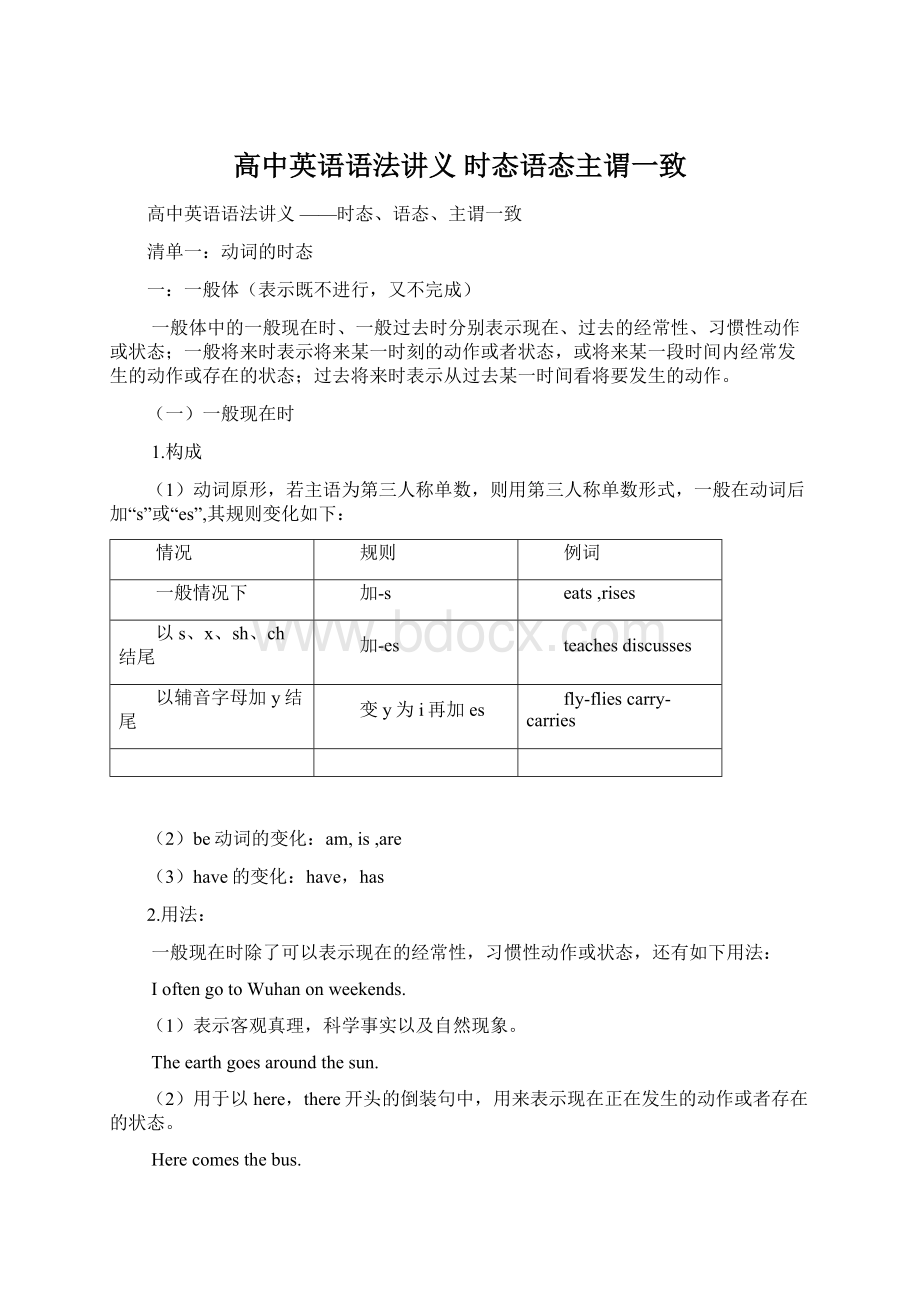高中英语语法讲义 时态语态主谓一致Word格式.docx
《高中英语语法讲义 时态语态主谓一致Word格式.docx》由会员分享,可在线阅读,更多相关《高中英语语法讲义 时态语态主谓一致Word格式.docx(18页珍藏版)》请在冰豆网上搜索。

2.用法:
一般现在时除了可以表示现在的经常性,习惯性动作或状态,还有如下用法:
IoftengotoWuhanonweekends.
(1)表示客观真理,科学事实以及自然现象。
Theearthgoesaroundthesun.
(2)用于以here,there开头的倒装句中,用来表示现在正在发生的动作或者存在的状态。
Herecomesthebus.
Theregoesthebell.
(二)一般过去时
(1)动词的过去式,其规则变化如下:
一般情况
加-ed
pack-packed
变y为i再加ed
carry-carried
以一个辅音字母结尾的重读闭音节词
双写辅音字母再加-ed
plan-planned
以不发音的e结尾的词
直接-d
like-likedprovide-provided
(2)was用于第一,第三人称单数,were用于其他人称
(3)以元音字母加y结尾的动词,一般直接加-ed。
如play-played,但pay-paid.
2.用法
一般过去时除了可以表示过去经常性、习惯性发生的动作或状态,还有下列用法:
(1)want,hope,think,intend等动词的一般过去式往往表示“过去原......”之意。
Ithoughthewasanhonestman.
Hedidn’tintendtohurtyou.
(2)wonder的一般过去时有时也可表示现在的行为,但语气要比用一般现在时更加委婉。
Iwonderedifyoucoulddomeafavor.
(3)usedto+动词原形,表示过去的习惯性动作而现在已经不再发生了。
Weusedtospendourvacationinthemountains.(现在不再了)
(三)一般将来时
1.构成
(1)shall+动词原形(第一人称)
(2)will+动词原形(各种人称)
一般将来时除了可以表示将来的动作或状态,还可以有以下用法:
(1)will+动词原形
will可用来表示事物的固有属性或必然趋势
Fishwilldiewithoutwater.(必然趋势)
will表示将来,有时含有偶然性、临时性决定的意思。
-----DoyouknowMr.Smithhascometoourtown?
-----No,Iwillgoandvisithimrightnow.(临时决定去拜访)
(2)begoingto+动词原形
“begoingto+动词原形”表示“计划,打算要做某事”,还可以表示有迹象发生某事。
HeisgoingtospeakonTVthisevening.(打算,计划做)
Lookatthedarkclouds.Itisgoingtorain.(乌云表示了有迹象发生)
(3)beaboutto+动词原形/beonthepointof+动名词表示“立即的将来”,因此,这两种结构不与表示将来的具体时间状语连用。
Thetrainisabouttostart.(马上发车)
Theplaneisonthepointoftakingoff.(马上起飞)
(4)现在进行时表将来:
现在进行时表示按计划、安排近期要发生的动作,常见的动词有(come,goarrive,leave,begin,start等)。
I’mleavingforBeijingnextweek.(近期)
(5)一般现在时表示将来:
某些动词的一般现在时可以表示计划、安排将要做的事情,常用于按列车、航班、电影、作息等时刻表。
Wemusthurryup.Thefirstclassbeginsat8o’clock.
(6)beto+动词原形
A/表示“按计划或安排要做的事”
Whenareyoutoleaveforhome?
也可用于过去时。
Was/weretodosth.表示曾经计划要做的事,但计划不一定完成,也可表示命中注定要发生的事;
was/weretohavedonesth.表示未曾实现的计划。
IfeltnervousbecauseIwassoontoleavehomeforthefirsttime.
Theysaidgoodbye,littleknowingthattheywerenevertomeetagain.
Weweretohavetoldyou,butyouwerenotin.
B/表示“应该”相当于should/oughttohavedone
Youaretoreportittothepolice.
C/表示“想,打算”,相当于intend/wantto+动词原形
Ifwearetobetherebeforeten,we’llhavetogonow.
(四)过去将来时
1.构成would/should+动词原形
表示从过去某一时间看将要发生的事情
Theysaidhewouldbehereateighto’clock
二.进行体
(一)构成
1.进行体包括
现在进行时:
am/is/are+现在分词
过去进行时:
was/were+现在分词
将来进行时:
will/shall+be+现在分词
2.现在分词的构成
加-ing
try-trying
双写辅音字母加-ing
regret-regrettingban-banning
去e,加-ing
hate-hatingdate-dating
(二)用法
1.表示某一时刻或现阶段正在进行的动作或状态(暂时性和未完成性)
Idon’treallyworkhere;
Iamjusthelpingoutuntilthenewteacherarrives.(暂时性)
2.表示某阶段正在进行的动作或发生的事,但说话的时候不一定正在进行,常与thesedays,thisweek等时间状语连用。
Wearemakingamodelplanesthisweek.
3.表示反复出现的或习惯性的动作,带有感情色彩,如赞赏、厌恶、遗憾等。
Heisalwaysborrowingmoneyfromme.
LiMingisalwaysmakingthesamemistake.
4.进行体表将来(见一般将来时具体用法)
5.不用于进行体的动词
(1)感觉类:
look,smell,fell,sound,taste,see,hear等
Thesouptastesgood.
Yourhandsfeelcold.
(2)情感类:
like,love,prefer,admire,hate,fear,adore等
Ilovemydadandmum.
(3)心态类:
wish,hope,want,need,believe,understand,agree,know,remember,forget等
Idon’tbelievemyeyes.
(4)存在状态类:
appear,lie(位于),remain,belong,have等。
ThosebooksbelongtoMr.Li.
三:
完成体
1.完成体包括
现在完成时:
have/has+过去分词
过去完成时:
had+过去分词
2.规则变化同过去式的构成方法,详见一般过去时规则变化。
(二)用法
1.现在完成时
(1)表示一个动作从过去开始,一直持续到现在,还有可能会继续持续下去。
常与表示从过去持续到现在并包括现在在内的时间状语有:
recently,lately,inthelast/pastfewyears/days/months,sincethen,uptonow,sofar等
Inthepastfewyears,greatchangeshavetakenplaceinWuhan.
Hehaswrittensomebookssofar.
(2)表示发生在过去的事情对现在产生的影响(重点在过去的事情对现在造成的影响上)。
常与already,just,yet,before等连用。
Theclasshasstarted.(Theclassisonnow.)
Hehasturnedoffthelight.(Thelightisoffnow.)
(3)在“最高级+名词”或“it/thisis+thefirst/second......time”之后的定语从句中,谓语动词用现在完成时。
Thisisthefirsttime(that)Ihavecomehere.
Thisisthebesttea(that)Ihaveeverdrunk.
(4)瞬间性动词:
又叫非延续性动词、终止性动词。
可用于完成时态,但不可与表示一段时间的时间状语连用;
若要连用需进行句式变换。
常见的瞬间性动词:
come,go,getto/reach,arriveat/in,leave,buy,sell,open,close,getup,join/takepartin,begin/start,return/give,borrow/lend,become/turn,bring/take,die,finish/end,receive/hearfrom...等
Hejoinedthearmy3yearsago.
Hehasbeenasoliderfor3years.
部分非延续性动词与延续性动词的转换
buy-have,borrow-keep,getmarried-bemarried,gettoknow-know,leave-beaway,comeback-beback,fallill-beill,die-bedead,turnoff-beoff,turnon-beon
2.过去完成时
(1)过去的过去:
一件事发生在过去,而另一件事发生在其之前,发生在前的动词要用过去完成时。
ShehadlearnedsomeEnglishbeforeshecametoWuhan.
Hesaidthathehadbeenabroadforthreeyears.
(2)表示从过去的某一时间开始,一直持续到过去的另一时间的动作,常用时间状语为:
by/until/before/bytheendof+“表示过去的某一时间”
BythenhehadlearnedEnglishfor3years.
Untilthenhehadknownnothingaboutityet.
(3)表示愿望、打算的过去完成时表示过去没有实现的愿望或者意图。
如:
hope,expect,mean,intend,want,suppose等。
IhadhopedtoseemoreofShanghai.(但没有如愿)
Ihadthoughtyouwouldcomethenextday.(但实际没来)
(4)用于某些固定句型里
A/Hardly/Scarcely/Barely...when...和Nosooner…than…句型中,when和than从句里用一般过去时,主句用过去完成时,且用倒装,表示“刚刚....就....”.
Hardly/NosoonerhadIgothomewhen/thanthetrainpoureddown.
Hardlyhadwestartedwhenthecargotaflattyre.
B/Itwas/hadbeen+一段时间+since从句。
That从句的谓语要用过去完成时。
Itwastenyearssincewehadhadsuchawonderfultime.
C/That/It/Thiswasthefirst/second...time+that从句。
That从句的谓语要用过去完成时。
Itwasthethirdtime(that)hehadmadethesamemistake.
四.完成体进行体
1.现在完成进行体:
have/has+been+doing
2.现在完成进行体是现在完成时和现在进行时的组合,因此,它既具备现在完成时的特征,又具备现在进行时的特征。
即它具备进行体的“未完成性,暂时性、感情色彩”。
HehasbeenlearningEnglishfor6years.
Ithasbeenrainingfor3days.
五.动词时态的呼应
(一)主将从现(主句用将来时,从句用现在时)
Whateveryousay,Iwillnotchangemymind.
Ifsheisstillwaiting,tellhertogohome.
(二)含宾语从句的句子的时态一致问题
宾语从句中的动词时态受主句谓语时态的制约,但主句谓语为现在时或将来时,从句中谓语可以不受影响。
Hesayshisfatheris/was/willbeateacher.
如果主句的谓语动词是过去时,宾语从句的谓语动词一般用过去的时态。
Iwassurehewasinbed.(主句动作与从句动作同时发生)
Hethoughthewasworkingforthepeople.(主句动作发生时,从句动作正在进行)
Iwonderedifshehadgotwell.(getwell先于wondered发生)
Hewantedtoknowwhatshehadbeendoing.(do从过去发生,直至wanted且在wanted)
IhopedI’dfindajobsoon.(find在hoped之后发生)
Ithoughtshe’dbegoingbybus.(gobybus在though之后发生)
注:
1.当主句为过去时,且宾语从句有明确的表过去的时间状语时,可不用过去完成时而用一般过去时。
Iknewhewasbornin1991.
2.当宾语从句表达永恒真理的时候,谓语动词不必变为过去时,采用一般现在时。
Thisprovedthattheearthisround.
(三)含虚拟语气的句子中时态一致问题
1.在“would(should/oughtto/could/might/needn’t/wouldliketo等)havedonesth,but......”句型中,but后面的谓语动词需要用一般过去时或者过去进行时。
Heshouldhaveturnedupbuthehadanunexpectedvisitor.
2.在“Butforthefactthat......”句型中,that从句的谓语动词需用一般过去时或过去进行时。
Butforthefactthatheisbusynow,hewouldbehere.
3.Itis(high/about)time+that从句,that从句中谓语动词需用一般过去时或should+动词原形。
Itistimethatwewenttobed.
六.易混时态的区别
(一)一般过去时和现在完成时的区别
一般过去时所表示的时间是确定的,纯属过去;
现在完成时说的是现在的情况。
Heservedinthearmyfrom2005to2010.(过去)
Hehasservedinthearmyfor5years.(现在)
Hewrotemanyplayswhenhewasatcollege.(过去)
Hehaswrittenmanyplays.(现在)
(二)一般过去时和过去完成时的区别
1.一般过去时指过去的动作或情况,而过去完成时指在过去的一个动词或者时间之前发生的动作或情况。
Hehadlearned3,000Englishwordsbeforehecametothisschool.
2.过去完成时的时间状语常用by或before和before引导的短语或句子表示,如bythattime,bytheendof,before2010,bythetime+句子(一般过去时)
Hehadfinishedwritingthebookbytheendoflastmonth.
(三)过去完成时与现在完成时的区别
两种都常与表示一段时间的状语连用。
但现在完成时表示的是延续到现在或同现在有关的动作,而过去完成时表示的是在过去某时之前已经完成或延续到过去时的动作。
Shehadbeenillforaweekbeforeshecameback.
Shehasbeenillforaweek.
正确时态填空
1.Janecan’tattendthemeetingat3o’clockthisafternoonbecauseshe(teach)aclassatthattime.
2.Thereportswentmissingin2012andnobody(see)themsince.
3.----Hi,let’sgoskating.
----Sorry,I’mbusyrightnow.I(fill)inanapplicationformforanewjob.
4.I’mcallingabouttheapartmentyou(advertise)theotherday.Couldyoutellmemoreaboutit?
5.Duringthelastthreedecades,thenumberofpeopleparticipatinginphysicalfitnessprograms(increase)sharply.
6.Writingoutalltheinvitationsbyhandwasmoretime-consumingthanwe(expect).
7.Theymadeuptheirmindthatthey(buy)anewhouseonceLarrychangedjobs.
8.Sofialookedaroundatallthefaces:
shehadtheimpressionthatshe(see)mostoftheguestsbefore.
9.Closethedooroffearbehindyou,andyou(see)thedooroffaithopenbeforeyou.
10.ThemanagerissaidtohavearrivedbackfromPariswherehe(meet)someEuropeanbusinesspartners.
答案;
1.willbeteaching2.hasseen3.amfilling4.advertised5.hasincreased6.hadexpected7.wouldbuy8.hadseen9.willsee10.hadmet
清单二动词的语态
一.被动语态:
1.构成由“助动词be+过去分词”构成,助动词be随着主语的人称、数和句子的时态的不同而变化。
被动语态形式表如下:
体时
现在
过去
将来
过去将来
一般
is/am/aredone
was/weredone
will/shallbedone
would/shouldbedone
进行
is/am/arebeingdone
was/werebeingdone
------
完成
have/hasbeendone
hadbeendone
-------
完成进行
(1)不知道谁是动作的执行者,或者没有必要指明动作的执行者。
---Thewindowisdirty.
---Iknow.Ithasn’tbeencleanedforweeks.
(2)需要强调或突出动作的承受者或事件本身。
Alltheemployeesexceptthemanagerareencouragedtoworkonlineathome.
(3)在文章标题、广告、新闻中。
GirlsWanted!
Five-Year-OldBoyKidnapped!
(4)当动作的执行者不是